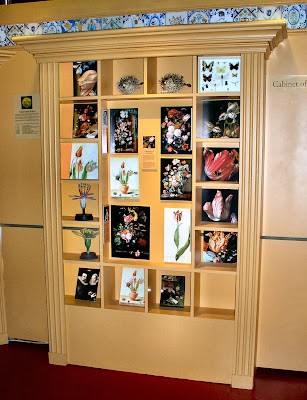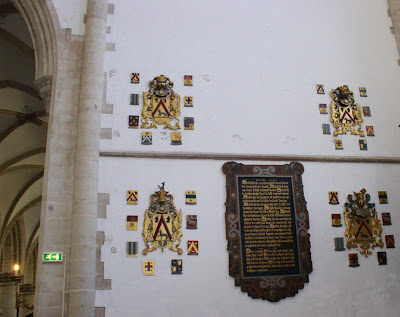The city of Haarlem is a 15-minute train ride from Amsterdam. It was once a wealthy North Sea trading port and retains its medieval character of cobblestone streets and gabled houses. It's the center of a major flower-bulb-growing region that produces tulips, hyacinths, crocuses, and daffodils. It is also famous for its art museums and hofjes (almshouses built around leafy courtyards). Haarlem lies between Amsterdam and the North Sea, on the Spaarne River, seven kilometers from the coast. The river, once the lifeblood of the city’s economy, winds its way through Haarlem. The city has a long history. From the 11th to the 13th centuries, Haarlem was the seat of the Counts of Holland, and received its municipal charter in 1245, making it the second oldest city in the Dutch heartland.

Mercury’s Foot (1996) by Ramon Spierings
The Roman god Mercury was the god of travelers, profit and trade, particularly of the grain trade. It was originally put here as a joke, but it is now considered a true piece of art by the city of Haarlem. The sculpture is on top of a public shower building for tourists and water sportsmen on the Spaarne River.
A typical residential lane in the old city center of Haarlem
The New York City neighborhood, Harlem, was named by the Dutch settlers after this city, originally, “New Haarlem.”
De Waag (Weigh House)
Weigh house masters needed to be able to judge the correct measure of a shipload of grain that was delivered in Haarlem. The weigh house was located on the Spaarne river. A large wooden crane operated by wheels driven by manpower was used to hoist the grain on ships into the Waag building and back into other ships or carts for further transport. Nowadays, the building has art exhibition space and also serves as a café catering to tourists.
Weigh House doors

Passageway to hofje (almshouse)
If you don’t know what you are looking for, you would not realize that this passageway leads to a hofje.
Almshouse Sign: The Hofje van Bakenes, an almshouse dating from 1395.
Almshouses are medieval retirement homes for elderly, poor women, built between the 13th century and 19th century. Almshouses were financed by the rich in order to improve their chances of getting into heaven. Haarlem used to have about 40 almshouses but now has about 20 in use. They are still committed to providing cheap accommodation for elderly ladies of modest means.

Almshouse courtyard
Almshouses typically consist of a central courtyard featuring a well-tended garden, with small apartments around it, hidden behind entrance gates.
Red light district
Haarlem has a small red light district, legal since the 1980s. The district has around 38 windows within private areas hidden from public view.
Laurens Janszoon Coster statue and St. Bavo's Church
A prominent statue located on the Grote Markt, Haarlem's Market Square, honors Laurens Janszoon Coster (1370-1440.) Born and raised in Haarlem, he's believed to have invented book printing in Haarlem somewhere around early 15th century. In his hand, Laurens holds a printing stick. This claim, or even his existence, cannot be verified. It's known as the Coster legend.
The Church of Saint Bavo
In the heart of the Grote Markt, Saint Bavo’s Church (1370-1520) is the city's most striking building. Saint Bavo is the patron saint of Haarlem. He is most often shown in Christian art as a knight with a sword and falcon. Stories about knights were very popular, and Haarlem was eager to show its patron Saint as a courageous knight. The painting, “Saint Bavo saves Haarlem from the Kennemers,” is dated 1673 but portrays the attack on Haarlem in 1274. The Kennemers were a war-like people from North Holland who fought with the Counts of Holland, rulers over Holland between the 10th and the 16th century, and lost to them in the Middle Ages.
The church of Saint Bavo was first built as a Catholic church in 1245 and was consecrated as a cathedral in 1559. Nineteen years later, Protestants confiscated the church during Martin Luther's anti-Catholic Reformation. The “reform” was continued in 16th century Europe by John Calvin, who believed that religious images encouraged superstition and idolatry; during the Iconoclastic Fury of 1566, Calvin’s followers stripped churches of painting and sculpture, took down statues of the saints and prophets, replaced stained glass with clear, and whitewashed over the painted stories from Old and New Testament on church walls. The Protestant church became a place where the devout could worship without distractions. Some religious reformers were sincere, but others manipulated the movement to gain control of valuable church property. At this time most of the art and silver artefacts were also seized, and what has survived is now in the collection of the Frans Hals Museum. The Haarlem Catholics took what they could carry with them and went underground, meeting thereafter in various clandestine houses of worship.

Mariakapel
In the Mariakapel (Mary’s Chapel), you can light a candle and say a prayer in commemoration of a loved one. At the entrance is a sculpture of Christ by the Flemish-Dutch sculptor Albert Termote. The sculpture welcomes visitors with a sign of ‘Pax’ (Peace). Inside the Chapel is a painting by the Amsterdam painter Bert Grotjohann. Two white birds in the painting are symbols of peace and also a Christian symbol for the Holy Spirit, God’s presence with mankind. Mary stood at the right of the cross; this is also the place of Mary’s Chapel. The north transept was dedicated to Mary, the south transept dedicated to the patron saint of the church, St. Bavo.

Christ with Peace sign
Dagkapel (Day Chapel)
Kerstkapel (Christmas chapel)
Rood Screen
The rood screen (or choir screen) is a common feature in late medieval church architecture. It is typically an ornate partition of open tracery between the choir or chancel (the area around the altar) and nave (the area set apart for lay people.) It provided a separation between the clergy and the parishioners. St Bavo’s rood screen is constructed of brass from 1517. In Old English, “rood” means “cross” or “crucifix.”
Dog Whipper
In some areas of Europe during the 16th to 19th centuries, household dogs often accompanied or followed their owners to church services. If these animals became disruptive, it was the job of the dog whipper to remove them from the church. There must have been plenty of troublesome dogs in church, because lots of oddly-rendered statues of dogs can be found inside St. Bavo, like the two-faced dog at the base of the rood screen.
Choir
The choir was built with heavy walls and columns and small light openings in the triforium (shallow arched gallery) high above the arches and an angular apse. This is the biggest choir on the continent.
Pulpit
The oldest part of the pulpit dates from circa 1434. The banisters are formed by two brass snakes, which symbolize evil fleeing the Word.
Pulpit base close up
Miniature Ships
In front of the former chapel of the Seamen's Guild hang three models of Dutch warships. The ship models were a gift from the Shipbuilders Guild. They date from the 16th and 17th centuries and are modeled on the ships that were built in Haarlem at the time.
18th century Mourning Shields
Important families had mourning shields hanging on the walls of the church. These four mourning shields belong to one family, buried in the church between 1733 and 1781. The gilded timber panel in the middle quotes a bible text from the gospel of St John.
Saint Bavo’s Nave and pipe organ
The nave and the choir are covered by wooden vaulting, which dates to the 16th century.
The impressive Müller organ dating from 1738 is probably the most recognizable instrument in the world. This grand organ occupies the whole west wall of the church and measures 100 feet high, with 5,000 pipes. The organ is richly gilded and decorated with more than 25 larger than life-size statues, all made by Jan van Logteren, a sculptor from Amsterdam.
Organ close-up
The pinnacle is crowned with two lion figures holding the coat of arms of Haarlem. “Vicit vim vertus” (Courage has conquered violence) is the motto of the city of Haarlem. This organ was once played by Händel and a 10-year-old Mozart in 1766. During the summer months, the church hosts free concerts.
Allegory of Faith
The marble relief (1735-1739) below the organ is by Jan-Baptist Xavery. The group represents ecclesiastical poetry and music, expressing their gratitude to Haarlem for the erection of the organ.
Gravestone Floor
The floor consists entirely of gravestones, some 1500, most from ancient times sad, macabre and fascinating, all at the same time. Graves allowed in the church until 1831. Many important townspeople throughout the centuries buried in the Great Church. The members of one family quite often buried under a family gravestone.

Vleeshal (Meat Hall)
The Meat Hall was built in 1603 to house both the municipal slaughterhouse and the butchers' guild, where butchers sold their goods. It is an example of Dutch Renaissance architecture and has been perfectly preserved as an annex of the Frans Hals Museum. The heads of bulls and rams on the façades are reminders of the original function of the building.
The little Vishuisje (fish house) in between the two main halls was once the home of the servant of the fish market across the square and serves as the entrance for museum De Hallen today
“Sunfighter” Sculpture (1977) by Arthur Spronken
A bronze sculpture originally designed to be placed on top of a huge fountain to be constructed on Market Square in 1967. Controversy over its design and size has left the sculpture with a tiny fountain that is inactive most of the time.
Sculpture & Becky

Hoofdwacht (Guard House)
The Hoofdwacht used to be the City Hall. The Town Guard made the former City Hall its home base in the 18th century. The guard defended the city, maintained order and decided when the city gates should be closed if danger threatened. Although the building was no higher than any of the other stone monuments on Market Square, this was where the order to close the city gates came from. How so? St. Bavo’s Church was manned 24 hours a day by the fire department and the town guard. If danger approached, the Hoofdwacht was alerted from the church tower. The Town Guard became obsolete and was disbanded early in the 20th century. It has since been used by the Historische Vereniging Harlem (Haarlem Historical Society), which researches and documents the history of the city.

Stadhuis (City Hall) and Market place stalls
Standing opposite Saint Bavo’s Church is the City Hall (Stadhuis), the oldest parts of which date back to 1250, with more recent features such as the external staircase, the north wing and the Neoclassical façade being added in the 1600s. The tower, Haarlem's greatest landmark and emblem, was rebuilt based upon original plans in 1913 (the original bell still rings at the beginning of council meetings). The interior is also of interest and includes numerous fine paintings, relics and mementos, along with fine woodcarvings (guided tours are available).
Café on square
Market Square, where 10 streets converge, is the town’s centerpiece. We stopped at this café for a piece of apple tart. (It was really good.)



























































